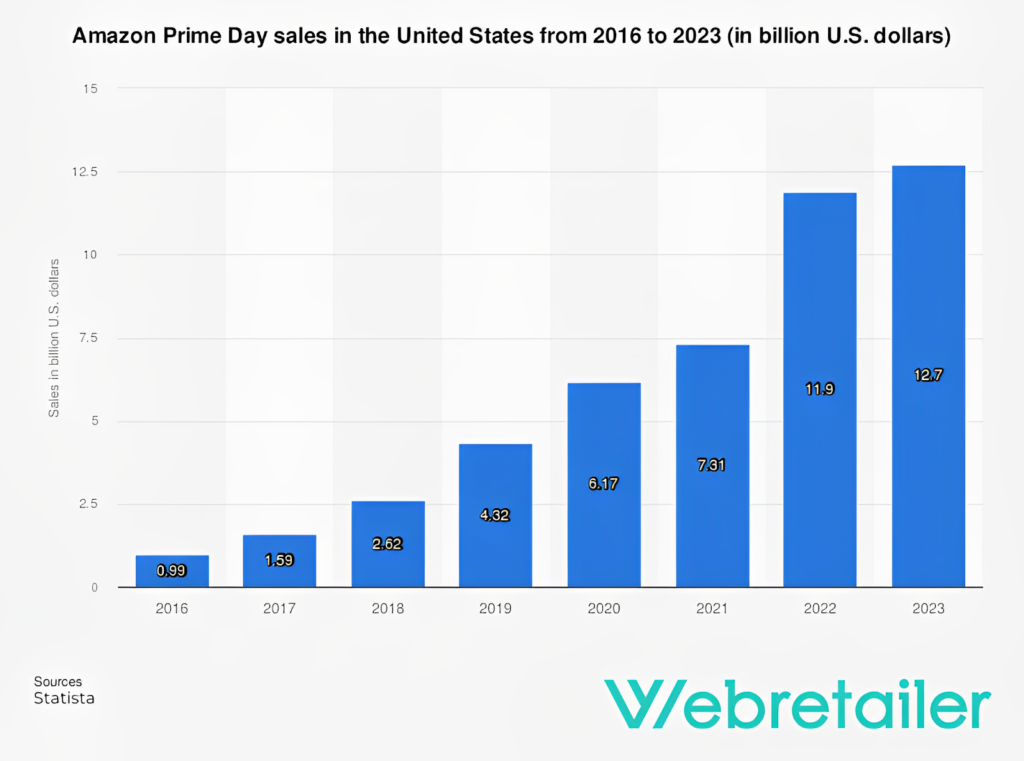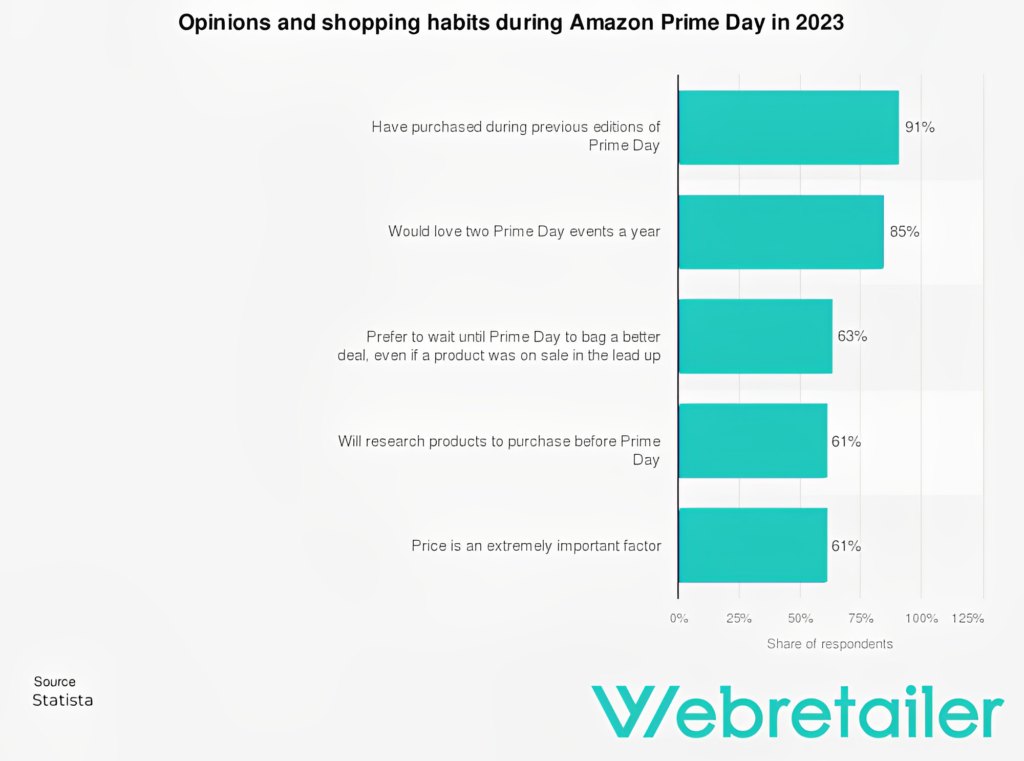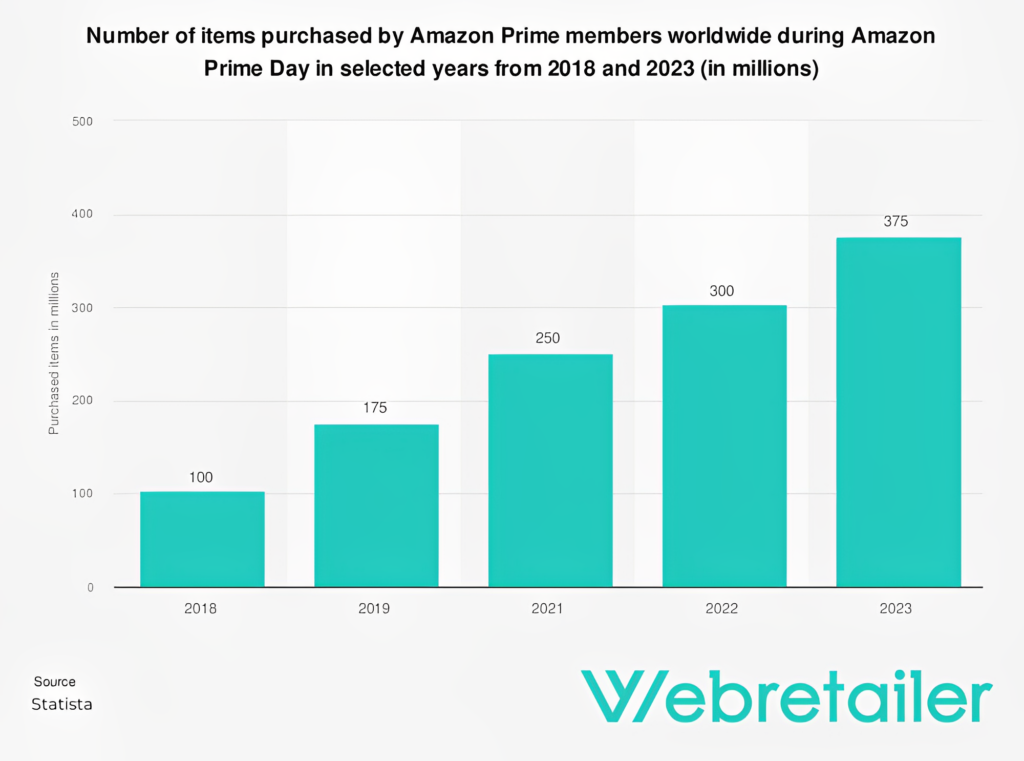As the dust settles on Amazon Prime Day 2023, it’s time to dig into the details and see if this hyped shopping event lived up to the soaring expectations. This year, the e-commerce titan’s sales festival made headlines once again, promising massive discounts and luring consumers to splurge.
But was it all hype, or did the event indeed reach new sales heights, setting yet another standard for retail extravaganzas? Let’s dissect the data, and assess whether Amazon Prime Day 2023 truly delivered on its promises.
Did Amazon Set a New Record?
Prime Day, Amazon’s two-day summer shopping spree, sent waves of excitement through the e-commerce sphere. After all, this event has been pumping a cool $10 billion into the company each year for the past three years.
2023 saw consumers rally with their wallets, spending an impressive $6.4 billion in just the initial 24 hours. According to data provided by Adobe Analytics, this represents a 6% increase from the previous year. Although this impressive total narrowly missed the forecasted amount, it still stood as the largest e-commerce shopping day of the year to date.
Vivek Pandya from Adobe Digital Insights shared some insight into the shoppers’ behavior, noting that people were acting on their bargain-hunting instincts and stocking up on favorites, particularly electronics and clothing.
MORE: Amazon statistics.
Amazon Prime Day Results
Here are the official Amazon Prime Day Sales results for 2023:
- Consumers spent $6.4 billion in the first 24 hours.
- Amazon Prime Day sales reached $12.7 billion during 48 hours.
- 375 million items were sold during Amazon Prime Day in 2023.
- The average shopping cart value was $56.07.
MORE: Shopify vs Amazon.
Amazon Prime Day Performance Statistics
Let’s unpack some of the most critical Amazon Prime Day performance statistics, comparing this year’s results with those of previous years. This comparative analysis will provide insightful implications for both sellers and consumers in understanding market dynamics and emerging trends:
Amazon Prime Day Sales in the US (2016 to 2023)

Amazon’s Prime Day sales have grown significantly in the past eight years. Starting from 0.99 billion USD in 2016, and reaching a whopping 12.7 billion USD in 2023. With a steady growth between 2016 and 2021, Prime Day exceeded expectations in 2021, earning more than 4 billion USD than in the previous year. The significant growth could have been due to the world slowly picking back up after the COVID-19 pandemic.
Opinions and shopping habits during Amazon Prime Day in 2023

It’s no wonder that Prime Day hit such a huge sales revenue — 91% of survey respondents confirmed that they have purchased during previous editions of Prime Day. That leaves only 9% who have not. 85% of respondents would love to have two Prime Day events per year. 63% of respondents prefer to wait until Prime Day to bag a better deal (even if the product was on sale during the lead up to Prime Day). 61% will research products to purchase before Prime Day, and also for 61% of respondents, price is an extremely important factor.
Number of items purchased by Amazon Prime members worldwide during Prime Day (2018-2023)

Since 2018, the number of items purchased by Amazon Prime members during Prime Day rose from 100 million to 375 million. The growth during the past five years has been slow and steady.
How Consumers Shopped on Amazon Prime Day
According to Numerator’s 2023 Live Prime Day Tracker, consumers had a clear inclination towards home goods, household essentials, and apparel. This information is backed up by responses from more than 1,800 real deal shoppers. The hot-ticket items ranged from Amazon’s own Fire TV Sticks to the sleek Apple Watch Series 8.
Numerator’s number crunchers also uncovered that the average shopping basket value saw a nice little bump from $53.14 last year to $56.07 this year. Plus, with over half of households placing at least two orders, the average household splurge hit over $140.
As the second day of the event unfolded, consumers remained captivated by appealing markdowns across a range of prominent categories. These included:
- electronics, offering savings as high as 14% off the retail price,
- apparel and toys both at a 12% discount,
- home & furniture with a 9% cut,
- computers at an 8% lower price,
- appliances and sporting goods reduced by 7% and 6% respectively,
- and televisions at a 5% discount.
Mobile devices made a significant contribution, accounting for 44.8% of online sales on July 12, an increase from the previous year’s 41.5%. This underscores the increasing ease with which consumers are turning to smaller screens for their shopping needs, particularly for those spontaneous, last-minute buys.
MORE: Prime Day marketing ideas to increase sales.
BNPL
In the realm of payment preferences, the ‘buy now, pay later’ option was a hit. It made up 6.4% of online orders, pulling in a hearty $461 million. That’s a 20% jump from last year’s Prime Day. Lastly, it’s worth mentioning the mobile shopping trend. Almost half of this year’s purchases were made from smartphones, painting a clear picture of how folks prefer to shop these days.
MORE: What is Amazon FBA?
Retail Outside of Amazon
Contrary to Amazon’s booming sales, other retailers didn’t share the same fortune. Salesforce reported that non-Amazon sales in the U.S. dipped by 10% compared to last year during the first day of the shopping extravaganza, and by 7% on the second day. Furthermore, the average discount rates fell to 18% this year, a sharp decrease from the 30% observed last year. Interestingly, according to the Commerce Cloud provider, higher discounts were seen around the 4th of July holiday, reaching a peak of 25%.
MORE: How to handle return and refunds after Prime Day.
Comparing Amazon Prime Day 2022
Amazon has remained silent about their 2022 Prime Day sales, however, Digital Commerce 360 projects global sales for the retail giant reached approximately $12.09 billion. This signifies an 8.1% surge from 2021 and aligns with the gentler annual growth Amazon experienced between 2020 and 2021.
According to estimates, Amazon’s Prime Day 2021 saw sales worth $11.2 billion, just a 7.7% increase from the $10.4 billion in 2020. This was a stark contrast from the notable 45.2% year-over-year surge in Prime Day sales between 2019 and 2020.
Digital Commerce 360’s estimates suggest that during the self-made retail festival spanning July 11 and 12, Amazon’s Prime Day sales reached a global total of $12.90 billion. This signifies a 6.7% year-on-year increase from the same shopping event in 2022, which took place on July 12 and 13.
MORE: How to sell on Amazon.
Key Takeaways
As we wrap up our deep-dive into Amazon Prime Day 2023, it’s clear that the shopping event continues to redefine retail norms, delivering record-breaking numbers while shaping consumer behavior. The increasing popularity of mobile shopping, the advent of ‘buy now, pay later’ options, and the focused interest in specific categories all highlight the evolving dynamics of the e-commerce landscape.
Despite a slight dip in non-Amazon sales, the overall trajectory points towards sustained growth in digital retail. As Amazon continues its trailblazing journey, it’s worth watching how these trends evolve in future Prime Day events, further driving the e-commerce narrative.
If you’re an Amazon seller, and you think that this is the time to optimize your listings, manage ads or enhance your store’s performance overall, then make sure to check out our list of Amazon tools and services.

Leave a Reply